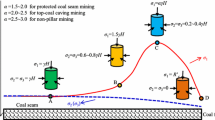Abstract
Rock burst is a serious geological hazard in deep underground mines affecting progress of mining operations. Although rock burst is a complex process, a distribution law of fractal characteristics can explain the rock failure mechanism. Using a servo-controlled testing system, uniaxial cyclic loading tests on coal rock specimens were conducted to investigate the fractal characteristics of the fragments under different loading rates. To comprehensively characterize the coal fragments of different sizes, samples were divided into four groups of different size: particles, fine, medium-size, and coarse fragments. The distribution of the fragments under uniaxial cyclic loading conditions was then investigated based on the theory of fractal geometry, and the relationships between fractal dimensions and loading rates. Under uniaxial cyclic loading and unloading conditions, most of the fragments are irregular wedges and bulks, exhibiting obvious shape characteristics. Under various loading rates, the length-quantity fractal dimensions of the coal fragments ranged from 0.74 to 1.44, the width-quantity fractal dimensions range from 0.44 to 1.65, and the thickness-cumulative mass fractal dimensions range from 1.0 to 1.33. The coal rock’s crushing size-mass fractal dimensions under different loading rates were 2.27, 2.30, 2.32, and 2.35, respectively. Under a small loading rate, the dimension-quantity fractal dimensions are relatively small, suggesting that the coal rock was less crushed, with large fragments differing greatly in length, width, and thickness. The results show that the coal rock fragments exhibit certain shape characteristics after the cyclic loading, like irregular shapes and wedges. Under a larger loading rate, the fragments showed greater fractal dimensions of both size and mass; the coal samples crushed more thoroughly with more uniform fragments in length, width, thickness and mass. The conclusions obtained in this study confirm the classification and fractal characteristics of coal rock fragments by uniaxial cyclic loading conditions in laboratory test and provide the basis for further study on the mechanism of rock burst. This study is helpful for us to make a thorough inquiry the danger degree of rock burst in coal mine by using fractal geometry, understand the effects of methane to coal and the evolution mechanism of cracks, and it can be applied to the research on occurrence mechanism and early warning of rock burst.












Similar content being viewed by others
References
Akdag S, Karakus M, Taheri A, Nguyen G, Manchao H (2018) Effects of thermal damage on strain burst mechanism for brittle rocks under true-triaxial loading conditions. Rock Mech Rock Eng 1–26. doi https://doi.org/10.1007/s00603-018-1415-3
Ángel F-TC, Luis Medina-Monroy J, Lobato-Morales H, Arturo Chávez-Pérez R, Calvillo-Téllez A (2016) A microstrip antenna based on a standing-wave fractal geometry for cubesat applications. Microw Opt Technol Lett 58(9):2210–2214
Bramowicz M, Kulesza S, Czaja P, Maziarz W (2014) Application of the autocorrelation function and fractal geometry methods for analysis of images. Arch Metall Mater 59(2):451–457
Cieśla M, Barbasz J (2013) Random packing of spheres in Menger sponge. J Chem Phys 138(21):214704
Da H, Tan Q, Huang R (2014) Fractal characteristics of fragmentation and correlation with energy of marble under unloading with high confining pressure. Chin J Rock Mech Eng 31(7):1379–1389
Engel P (1983) The fractal geometry of nature (book review). Sciences 23:63–68
Hou T, Xu Q, Zhou J (2015) Size distribution, morphology and fractal characteristics of brittle rock fragmentations by the impact loading effect. Acta Mech 226(11):3623–3637
Jevric M, Knezevic M, Kalezic J, Kopitovic-Vukovic N, Cipranic I (2014) Application of fractal geometry in urban pattern design. Tehnicki Vjesnik 21(4):873–879
Kong X, Wang E, Hu S, Shen R, Li X, Zhan T (2016) Fractal characteristics and acoustic emission of coal containing methane in triaxial compression failure. J Appl Geophys 124:139–147
Liu R, Jiang Y, Li B, Wang X (2015) A fractal model for characterizing fluid flow in fractured rock masses based on randomly distributed rock fracture networks. Comput Geotech 65:45–55
Liu R, Li B, Jiang Y (2016) A fractal model based on a new governing equation of fluid flow in fractures for characterizing hydraulic properties of rock fracture networks. Comput Geotech 75:57–68
Mahjani M, Moshrefi R, Sharifi-Viand A, Taherzad A, Jafarian M, Hasanlou F (2016) Surface investigation by electrochemical methods and application of chaos theory and fractal geometry. Chaos, Solitons Fractals 91:598–603
Nagahama H (2000) Fractal scalings of rock fragmentation. Earth Sci Fron 7(1):169–177
Sui L, Yang Y, Ju Y (2014) Fractal description of rock fracture behavior. Mec Pract 36:753–756
Tian B, Liu S, Zhang Y, Wang Z (2016) Analysis of fractal characteristic of fragments from rock burst tests under different loading rates. Tehnicki Vjesnik 23:1269–1276
Wang G, Gong S, Li Z, Dou L, Cai W, Mao Y (2016) Evolution of stress concentration and energy release before rock bursts: two case studies from Xingan coal mine, Hegang, China. Rock Mech Rock Eng 49(8):3393–3401
Wold M, Connell L, Choi S (2008) The role of spatial variability in coal seam parameters on gas outburst behaviour during coal mining. Int J Coal Geol 75(1):1–14
Wong T-f, Wong RHC, Chau KT, Tang CA (2006) Microcrack statistics, Weibull distribution and micromechanical modeling of compressive failure in rock. Mech Mater 38(7):664–681
Wu Q, Liu Y, Yang L (2011) Using the vulnerable index method to assess the likelihood of a water inrush through the floor of a multi-seam coal mine in China. Mine Water Environ 30(1):54–60
Funding
This research was financially supported by the Natural Foundation of Shandong Province (ZR2016EEB07), Scientific Research Foundation of Shandong University of Science and Technology Talents (No. 2016RCJJ025), Basic Research Project of Qingdao Source Innovation Program (No. 17-1-1-11-jch), and Taishan Scholar Talent Support Plan for Advantaged & Unique discipline Areas.
Author information
Authors and Affiliations
Contributions
Yangyang Li conceived and designed the experiments and analyzed the data; Shichuan Zhang performed the experiments and wrote the paper.
Corresponding author
Ethics declarations
Conflict of interest
The authors declare that they have no conflict of interest.
Rights and permissions
About this article
Cite this article
Li, Y., Zhang, S. & Zhang, X. Classification and fractal characteristics of coal rock fragments under uniaxial cyclic loading conditions. Arab J Geosci 11, 201 (2018). https://doi.org/10.1007/s12517-018-3534-2
Received:
Accepted:
Published:
DOI: https://doi.org/10.1007/s12517-018-3534-2



